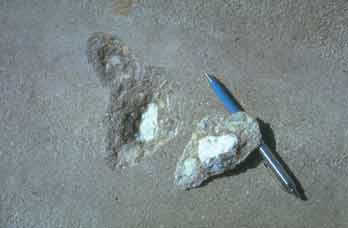Icemelters and Concrete Damage
To look at all of our top lines of icemelters that are not only gentler on concrete; but sodium chloride (rock salt) free and pet-safe, CLICK HERE for more information from the US leaders in organic and eco-friendly products!
Winter brings the most picturesque scenes: families playing in the snow, friends around the fireplace and ski trips, but it also brings a rise in weather related problems. Of these, ice and its removal are among the most critical. Unfortunately, there are a small percentage of those who crack their ice dilemma only to face another problem when spring arrives; damaged concrete. There is much confusion surrounding this damage which is mostly caused by the freeze/thaw cycle. Too often people attribute concrete damage to the icemelter that was used. It is the purpose of this bulletin to help you better understand: the types of damage that happens to concrete, what causes them, and how to repair and prevent further damage.
Chemical Damage from Icemelters
According to the American Concrete Institute (ACI), which is a leading United States concrete authority that sets many of the guidelines and standards that are used today in the designing, planning, construction and inspection of concrete structures, there are several chemicals, some of which are used in icemelter formulas that actually attack concrete, and are best avoided. They are:
Aluminum Chloride, Ammonium Nitrate, Ammonium Sulfate ,Ammonium Chloride, Calcium Sulfate, Magnesium Sulfate, Magnesium Chloride, Sodium Cyanide.
Freeze/Thaw Cycle Damage
By far the most risk of damage to your concrete during the winter months is attributed to the freeze/thaw cycle. To put this in sample terms, it is the build up of water [melted ice] being absorbed into the porous concrete, which then freezes and expands. This expansion within the concrete causes pressure to build up and eventually this build up will exceed the limit that the concrete was built to withstand. When the pressure becomes too much for the concrete to withstand, scaling generally occurs.
The concrete absorbing the melted ice [water] is a fact of nature and cannot be blamed on the icemelter  used. It can be likened to a sponge absorbing water. However, it should be noted that when you use an icemelter, you will have more melted ice [water], and therefore the potential of more water seeping into the concrete than if you left the ice in its frozen state. Of course, not taking steps to remove the ice on a walkway may put yourself at risk from a liability standpoint, so what is one to do?
used. It can be likened to a sponge absorbing water. However, it should be noted that when you use an icemelter, you will have more melted ice [water], and therefore the potential of more water seeping into the concrete than if you left the ice in its frozen state. Of course, not taking steps to remove the ice on a walkway may put yourself at risk from a liability standpoint, so what is one to do?
As mentioned earlier, the freeze/thaw cycle is a natural process and there is no way of eliminating it. However to reduce the damage caused by this cycle, we strongly recommend that after applying the icemelter and when the ice turns into slush, that the slush be removed from the concrete pavement, sidewalk or driveway to reduce the amount of water that may penetrate the concrete thus reducing the pressure build up.
Another way of reducing the damage caused by the freeze/thaw cycle is to use an icemelter that will keep melted ice in a liquid state for a longer period of time. For example, icemelter containing calcium chloride tends to re-freeze more quickly compared to icemelter containing potassium chloride. By using a potassium chloride product, you extend the time available for more melted ice [water] to drain off your concrete or evaporate, resulting in less water being absorbed by the concrete.
Another type of damage that can be attributed to the freeze/thaw cycle is a popout. Popouts occur due to internal swelling in the concrete causing small fragments of concrete to break away from the surface. Popouts are usually caused by highly absorbent rocks that are not capable of holding a lot of pressure. When freezing occurs under moist conditions, the rock will swell up and when there is sufficient internal pressure, the rock will break from concrete surface.
Repair & Prevention
Scaling and Mortar Flaking: Many things can be done to prevent or reduce the risk of this damage occurring. For example, concrete that is properly air-entrained - that is, concrete containing enough small air pockets – will better resist scaling and mortar flaking caused by the freeze/thaw cycle, since these air pockets help to cushion the pressure caused by freezing of the absorbed water. Another example, is to ensure your concrete is of the highest quality and standard. To this end, there are several important points that one should know:
- A high graded and durable concrete mix should be used.
- The concrete is to be properly sloped to ensure that water drains away from the slab.
- Proper finishing practices are also important for the creation of a strong concrete slab.
- The concrete must be cured promptly followed by an air-drying period.
How to Repair Freeze Thaw Damage
According to the Portland Cement Association (PCA), another leading concrete authority, that to protect against further freeze/thaw damage a breathable surface treatment may be applied on the concrete. Impermeable materials such as epoxies should not be used because moisture can be trapped in the concrete which could lead to further damage.
Oil treatment such as linseed oil, silane, siloxane, or other materials are recommended. Linseed oil treatment consists of two applicants. Combining equal parts of commercially boiled linseed oil with a solvent such as turpentine or mineral spirits, the recommended coverage for the first application is roughly 40 to 50 sq. yd per gallon [9-11 m/liter]. The second application should roughly be 70 sq. yd. gallon [15 m/liter]. To make sure that the oil treatment is successful, the temperature of the concrete at the time of application should be 50°F (10°C) or above. This allows for sufficient drying to take place.
|
|
Caution:The surface may be slippery after the application therefore the surface should be kept clear. |
Popouts
There are several ways to minimize or eliminate popouts:
- Use concrete with the proper water-cement ratio.
- Use air-entrained concrete.
- Use a durable crushed-stone in the composition of your concrete.
- Slope the slab surface to ensure proper drainage.
- Reduce concrete temperature to 50°F to 70°F (10°C to 21°C).
- Do not finish concrete with bleed water on the surface.

To repair popouts, one can fill in the patch left behind with a dry-pack mortar, epoxy mortar, or other appropriate patch material. For a surface that has numerous popouts, a thin-bonded concrete overlay may be used to cover up the cosmetic detraction.
Damaged or New Concrete
It is not recommend that icemelter be used on damaged concrete. Damaged concrete will absorb the water [melted ice] more readily since its ‘seal’ has been broken and therefore can be more susceptible to damage. It is best to reseal or treat your damaged concrete as mentioned earlier, before using any icemelter on it. Further, it is recommended that for concrete less than 12 months old that NO icemelter be used. Newly poured concrete needs time to cure and settle. The application of icemelter on concrete less that 12 months old may weaken the concrete structure making it more susceptible to damage in the future. In order to reduce slipping, falling and liability risks, we suggest applying sand or gravel on the new concrete slab to give it some traction.
Icemelters on Concrete
As important as it is for one to know the makeup of their concrete, they should also understand how various ice melting products will affect their concrete and its immediate environment. Sodium chloride for example, will attack the metal rebar contained within the concrete when it is soaked up into the concrete and also damages surrounding vegetation, soil structure and ground water. Calcium chloride, which tends to leave an oily residue on your concrete surface, will actually discolor concrete. It does this by accelerating the hydration process, while having a retarding effect on hydration of the ferrite compound in Portland Cement. Magnesium chloride, ammonium nitrate and ammonium sulfate attack and disintegrate concrete and should be strictly avoided.
On the other hand, urea will not chemically damage concrete, however it contains nitrogen, which breaks down to ammonia and is quite toxic to aquatic life. A great choice to consider for your concrete, is a fertilizer based icemelter, such as XYNYTH Manufacturing’s Mountain Organic Natural icemelter, which is potassium based. It actually reduces the change of damage to surfaces by preventing refreezing of the melted ice longer than other icemelters and by leaving no residue behind. It is also good for the vegetation and safe on the eco-systems.
|
Damage to concrete is rarely caused by the icemelter used but rather by the effects of the freeze/thaw cycle. Your risk of damage can be reduced substantially by remembering these few points:
|
This bulletin provides a general guideline on the causes of concrete damage and ways to repair and prevent them. For more detailed information, please consult your local ice melt distributor.
To look at our top line of icemelters that are not only gentler on concrete but sodium chloride free and pet-safe, CLICK HERE for more information from the US leaders in organic and eco-friendly products!
You can also e-mail or call us directly at (866) 374-5101 or info@GreenEarthAgAndTurf.com for more detailed product information and other bulk wholesale icemelter options from the US Leaders in Organics & Eco-Friendly products.



